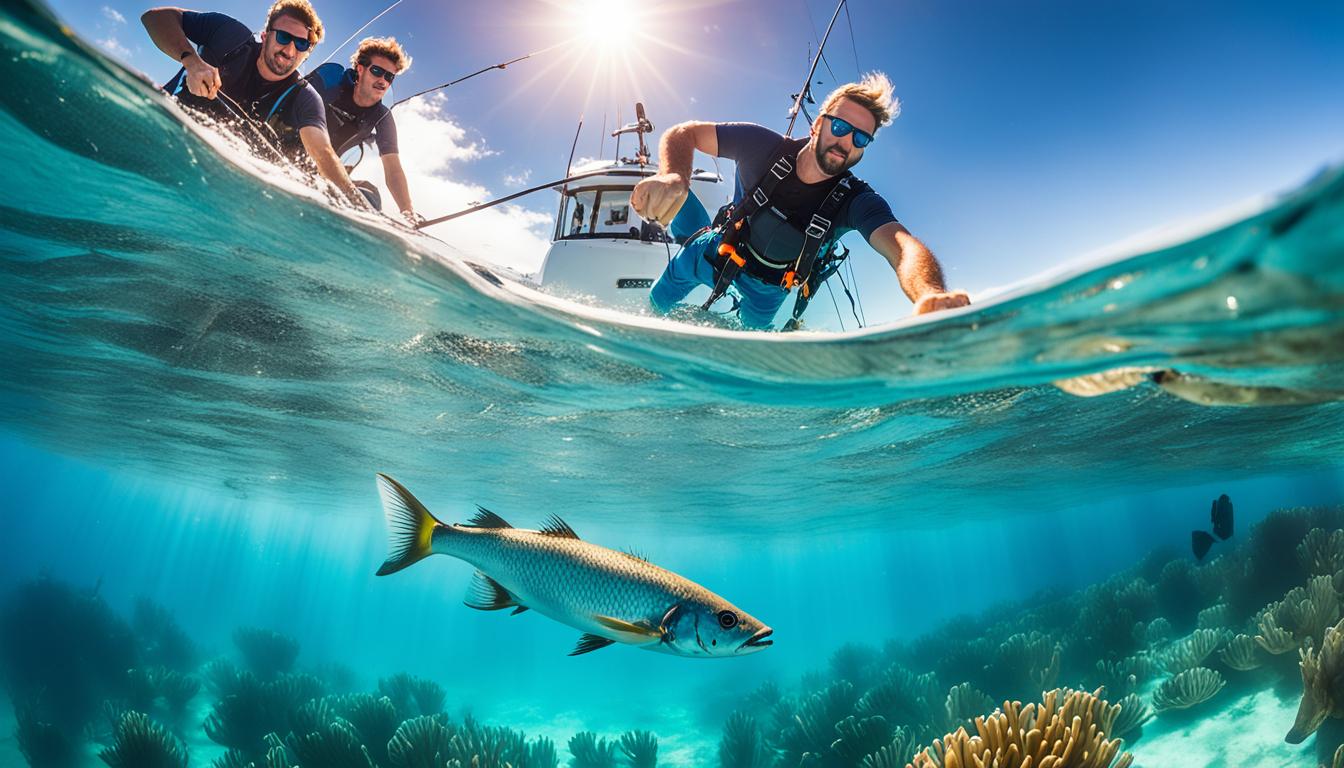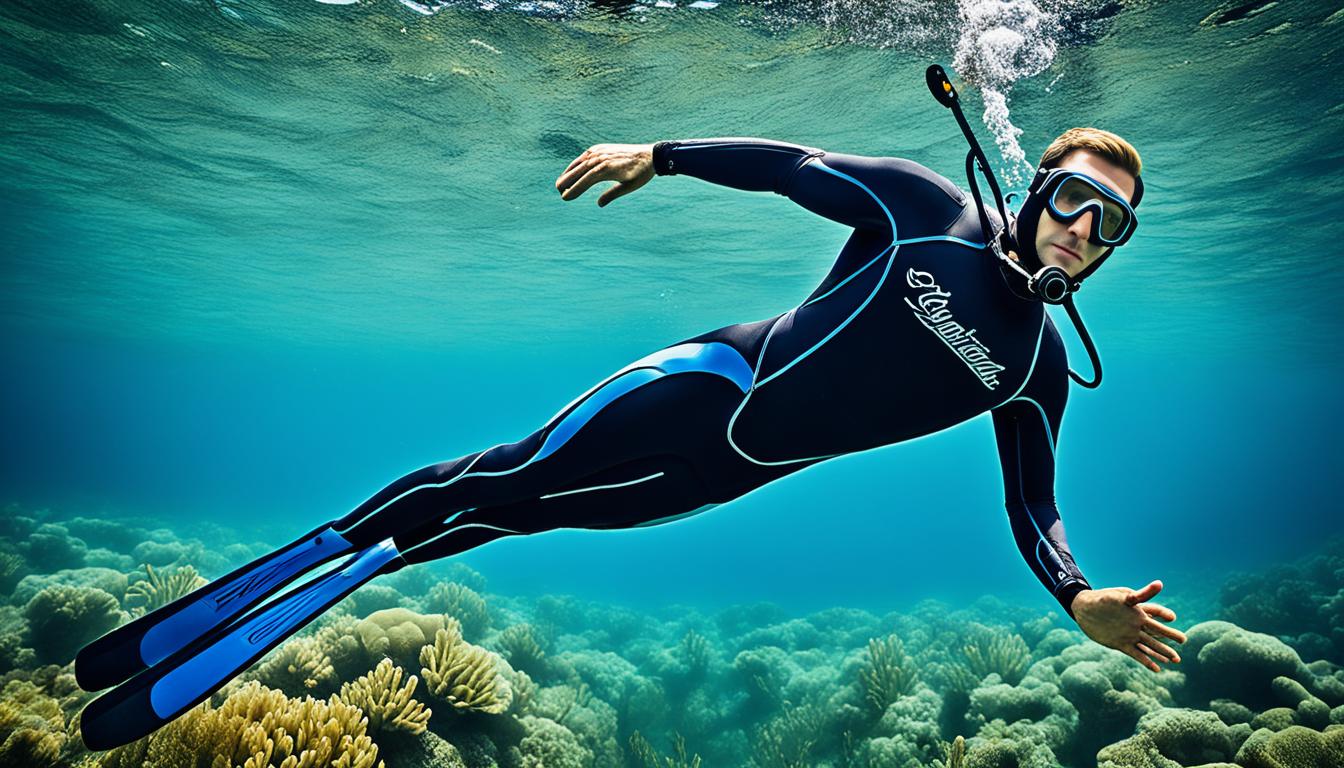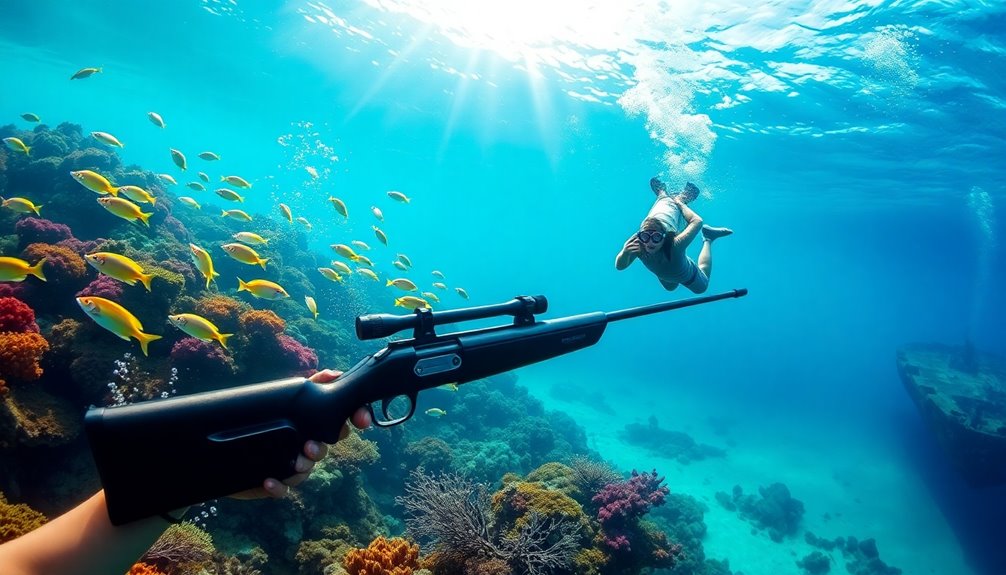Spearfishing in the Whitsundays is an adventure like no other. With its stunning cluster of 74 islands off the northern Queensland coast in Australia, this region offers spearfishing enthusiasts the perfect playground to explore the underwater world. Whether you’re a seasoned pro or a beginner, the Whitsundays will captivate you with its warm waters, incredible marine life, and breathtaking natural beauty.
Key Takeaways:
- Explore the Whitsunday Islands, a cluster of 74 stunning islands off the coast of Queensland, Australia.
- Discover the best spearfishing hotspots, techniques, and tips for an unforgettable adventure.
- Enjoy eco-friendly fishing with regulations in place to ensure sustainable practices.
- Experience warm waters, good visibility, and diverse marine life in the Whitsundays.
- Embark on an exciting spearfishing journey in this pristine paradise.
Imagine diving into crystal-clear waters surrounded by colorful coral reefs and an abundance of fish species. The Whitsundays offer an underwater paradise where you can test your skills and immerse yourself in nature. From the moment you descend beneath the surface, you’ll be greeted by an array of marine life, including tropical fish, turtles, and even magnificent manta rays.
As you swim through the Whitsunday Islands, you’ll discover an underwater wonderland of vibrant coral gardens. The Great Barrier Reef Marine Park Authority maintains over 100 public moorings throughout the area, ensuring the preservation of this precious ecosystem. With over 1,500 species of fish, spotting unique and exotic creatures is just part of the adventure.
But spearfishing in the Whitsundays is not just about the sport itself. It’s about the entire experience. In between dives, you can relax on the pristine Whitehaven Beach, accessible only by boat or air. With its 7km stretch of pure white sand, this breathtaking national park provides a tranquil oasis where you can unwind and soak up the sun.
For those seeking even more adventure, day tours from Airlie Beach and the islands offer opportunities for snorkeling, scuba diving, sailing, and of course, fishing. Overnight sailing tours are also available, allowing you to spend more time exploring the wonders of the Whitsundays.
If you prefer a more independent experience, bareboating is a unique option in the Whitsundays. Rent a yacht and set sail without a license, exploring the hidden coves and secret spots that only the adventurous few get to discover.
So grab your spearfishing gear, pack your sense of adventure, and get ready to embark on the ultimate spearfishing journey in the Whitsundays. From thrilling encounters with marine life to the stunning natural beauty of the islands, this adventure will leave you with memories to last a lifetime.
Spearfishing Whitsundays: The Best Hotspots
The Whitsundays is a paradise for spearfishing enthusiasts, with its pristine waters and abundant marine life. Whether you’re a beginner or an experienced spearfisher, this tropical destination offers a variety of hotspots that are sure to excite and challenge you. Here are some of the best spearfishing locations in the Whitsundays:
1. Reefs and Offshore Islands
The headlands and passages between the islands are excellent places to explore and hunt for your catch. Nara Inlet is particularly popular for catching Giant Trevally, while Daydream Island’s rocky headlands are known for Giant Trevally and Mackerel. Make sure to explore the reefs and bommies surrounding Double Cone Island for great spearfishing opportunities.
| Fishing Spot | Target Species |
|---|---|
| Nara Inlet | Giant Trevally |
| Daydream Island | Giant Trevally, Mackerel |
| Double Cone Island | Giant Trevally, Coral Trout, Cod, Queenfish |
2. Mainland Fishing Locations
If you prefer fishing on the mainland, there are several popular spots to choose from. Shute Harbour public fishing pontoon, VMR Rockwall (Whisper Bay), and Cannonvale Beach are well-known for their abundance of fish species. Don’t miss Windy Bay on the northwest of Haselwood Island, where you can find some of the best catches recommended by our staff.
| Mainland Fishing Spot | Target Species |
|---|---|
| Shute Harbour public fishing pontoon | Giant Trevally, Spanish Mackerel |
| VMR Rockwall (Whisper Bay) | Fingermark, Golden Trevally, Permit, Bream, Barramundi |
| Cannonvale Beach | Various species |
3. Island Adventures
For those looking to venture to the islands, Hook Passage is considered one of the best fishing and spearfishing spots in the Whitsundays. South Molle Island’s reef off the southwestern tip is ideal for catching Mackerel, while the southern end of Whitsunday Island’s fringing reefs is known for its variety of species including Sweetlip, Cod, Spangled Emperor, and Coral Trout. If you’re visiting Hayman Island, don’t forget to explore ‘The Paddock’ for opportunities to catch Coral Trout, Trevally, and game fish.
| Island | Target Species |
|---|---|
| Whitsunday Island | Sweetlip, Cod, Spangled Emperor, Coral Trout |
| South Molle Island | Mackerel |
| Hayman Island | Coral Trout, Trevally, Game fish |
When spearfishing in the Whitsundays, it’s important to respect the regulations set by the Great Barrier Reef Marine Park Authority. Some areas have restrictions, such as fishing closures during coral fish spawning periods and prohibited fishing at Whitehaven Beach. Remember to check the rules for each location and exercise responsible fishing practices to protect the marine ecosystem.
What to Catch in the Whitsundays
When it comes to spearfishing in the Whitsundays, you can expect an abundance of species to target. Whether you’re exploring the vibrant reefs or venturing offshore, the waters here are teeming with a variety of marine life waiting to be caught. Let’s take a look at some of the exciting species you can encounter during your spearfishing adventure in the Whitsundays.
On the Reefs
When diving on the reefs, you’ll have the opportunity to hunt for Snapper, Bream, Coral Trout, Parrotfish, Leatherjackets, Morwong, and more. These species are known for their vibrant colors and delicious flavors, making them popular targets among spearos. Remember to follow sustainable fishing practices and adhere to catch limits to ensure the long-term health of these reef ecosystems.
Offshore Challenges
For more experienced spearos looking for a thrill, venturing offshore in the Whitsundays offers an array of challenging species. Sailfish, Wahoo, Narrow-barred Spanish Mackerel, Yellowtail Kingfish, and other pelagic fish await those who dare to explore the deep blue. These larger and more elusive targets require skill, precision, and a deep understanding of their behavior.
However, it’s important to note that certain species, such as Great White Sharks, Grey Nurse Sharks, and Blue Groper, are protected in the Whitsundays. If you come across these incredible creatures during your spearfishing expedition, admire them from a distance and report your sighting to the authorities. Let’s ensure the preservation of these magnificent species for generations to come.

Safe and Sustainable Catch
While the thrill of the catch is undoubtedly exciting, it’s essential to prioritize safety and sustainability. Larger fish tend to accumulate more toxins, making them less safe for consumption. To ensure the health and well-being of yourself and your fellow spearos, aim for a catch that weighs less than 4 kilograms.
Tournaments and Seasons
The Whitsundays provide an excellent platform for fishing tournaments throughout the year, with major meetings held in November and December. During the winter months, from mid to late May until late September or early October, the region experiences significant runs of Spanish Mackerel. However, mackerel can be caught at any time of the year. In the summer, the Whitsundays transform into a prime billfish area, where black marlin, swordfish, sailfish, and tuna are abundant.
Resources for Fishing Enthusiasts
For fishing enthusiasts who want to learn more about identifying fish species and obtaining fishing reports in the Whitsundays, the Department of Agriculture and Fisheries website is an invaluable resource. Take advantage of the information available to enhance your spearfishing experience and make informed decisions about your catch.
Remember to adhere to local fishing regulations, respect protected areas, and practice responsible spearfishing techniques to ensure the sustainability of the Whitsundays’ marine ecosystem.
Spearfishing Gear for the Whitsundays
When embarking on a spearfishing adventure in the Whitsundays, having the right gear is essential to ensure a successful and enjoyable experience. Here are some key pieces of spearfishing gear that you should consider:
Wetsuit
A proper wetsuit is crucial to protect you from the varying water temperatures in the Whitsundays. It provides insulation and helps you stay warm during your spearfishing sessions. Make sure to choose a wetsuit that fits well and suits the conditions you’ll be diving in.
Shark Shield
As spearfishing takes place in the ocean, encounters with marine life, including sharks, are a possibility. A shark shield is a device that emits an electric field to deter sharks from approaching you. It adds an extra layer of safety and peace of mind while you’re in the water.
Diving Knife
A diving knife is an essential tool for safety purposes. It can be used to help free yourself from tangled lines or webs, cut through ropes, and in worst-case scenarios, defend yourself from marine creatures. Choose a dive knife with a secure sheath for easy access and safe storage.
Spearfishing Equipment
Investing in gear specifically designed for spearfishing can greatly enhance your experience. This includes a speargun, spearfishing fins, a snorkel, and a mask. Having reliable and efficient equipment tailored for spearfishing will improve your hunting ability and increase your chances of success.
Other Recommended Gear
In addition to the essential spearfishing gear, there are a few other items that you should bring along. These include sunscreen to protect your skin from the sun, towels to dry off after your dives, clothes for when you’re on the boat, and a GoPro or underwater camera to capture your underwater adventures.
It’s also a good idea to bring your own alcohol and a drink bottle for filtered water refills. While the charter provides filtered water and other beverages, having your own alcohol and a reusable drink bottle ensures that you have your preferred drinks and stay hydrated throughout the trip.
Remember, the Whitsundays offer limited areas for spearfishing, and it’s important to comply with the regulations to protect the marine environment. Respect the local rules and regulations, and enjoy your spearfishing adventure in the stunning waters of the Whitsundays!

| Recommended Gear | Price |
|---|---|
| Wetsuit | $200 – $500 |
| Shark Shield | $600 – $800 |
| Diving Knife | $50 – $150 |
| Spearfishing Equipment | $500 – $1000 |
Spearfishing Techniques in the Whitsundays
When it comes to spearfishing in the Whitsundays, mastering the right techniques is crucial for a successful catch. Whether you’re a beginner or an experienced spearo, these techniques will help you make the most of your spearfishing adventure.
1. Freediving Skills
Since scuba diving is generally not allowed in most areas of the Whitsundays, freediving is essential. Focus on developing your breath-holding abilities and finning techniques to move stealthily through the water. Take advantage of the included Freediving Theory Workshops and Spearfishing Course to enhance your skills.
2. Fish Behavior and Stalking
To increase your chances of success, it’s important to understand fish behavior. Learn about the habits and preferred hiding spots of different species. Practice stalking techniques, such as moving slowly and quietly, to get close to your target without alarming them.
3. Target Acquisition and Accuracy
When spearfishing, it’s crucial to identify your target quickly and accurately. Use your knowledge of fish species to distinguish between target and non-target fish. Improve your aim and spear throwing skills through practice and training dives arranged by the crew. For those engaging in spearfishing for beginners, it’s important to start with easier, more abundant species to build confidence and improve accuracy. Additionally, always prioritize safety by being aware of your surroundings and ensuring you have a clear shot before releasing the spear. With time and experience, you’ll become more adept at both identifying species and executing precise shots.
4. Patience and Observation
Spearfishing requires patience and observation. Spend time observing fish movements, patterns, and feeding behaviors. Look for signs of fish activity, such as bubbles or ripples in the water. Pay attention to the advice and recommendations of the experienced crew members who scout and select the best spearfishing sites.
5. Safety Precautions
Always prioritize safety when spearfishing in the Whitsundays. Make sure you meet the minimum age and swimming requirements and have the necessary certifications. Respect all fishing regulations and guidelines to protect both yourself and the marine environment. Remember to bring suitable snorkeling and fishing equipment, such as guns, masks, snorkels, fins, and knives.

| Charter Details | Whitsundays Spearfishing Charter |
|---|---|
| Duration | 5 days and 4 nights liveaboard maxi yacht trip |
| Accommodation | Dorm style onboard the yacht |
| Meals | All meals and snacks provided by the crew |
| Crew | A skipper and two deckhands/hosts |
| Freediving Workshops | Included |
| Spearfishing Course | Offered |
| Training Dives | Arranged |
| Age Requirement | 18 and above |
| Safety Certifications | All Freediving Certifications included |
| Deposit | Non-refundable |
| Final Payment Due | 10 weeks before the trip commences |
| Insurance | Recommend purchasing travel insurance for any overseas trips. |
| Price | $2000 |
| Satisfaction Rating | 4.9 out of 5 stars on Google |
Spearfishing Tips for the Whitsundays
When embarking on a spearfishing adventure in the Whitsundays, it’s essential to keep a few tips in mind to ensure a safe and successful experience. These spearfishing tips Whitsundays will help you make the most of your time in this highly-visited region while adhering to the necessary rules and regulations.
1. Stay Informed and Prepared
Prior to your spearfishing excursion, take the time to educate yourself about the local weather conditions, water currents, and the types of fish species found in the Whitsundays. This knowledge will give you important insights into the best spots and strategies for spearfishing success. Additionally, always check the latest zoning rules and restrictions to avoid hefty fines of up to $2100 for non-compliance.
2. Ensure Safety First
While spearfishing is an exciting activity, safety should be your top priority. Remember to wear a full wetsuit to protect yourself from potential hazards, such as coral, jellyfish, or stinging creatures. It is also highly recommended to use a shark shield, which can help deter sharks and provide an added layer of protection.
3. Follow Catch Limits and Size Restrictions
Responsible spearfishing involves respecting catch limits and size restrictions set in place for sustaining fish populations and protecting the marine ecosystem. By adhering to these regulations, you contribute to the conservation efforts in the Whitsundays and ensure the availability of fish species for future generations.
4. Handle Potentially Dangerous Fish with Caution
Some fish species in the Whitsundays can be dangerous due to their venomous nature or size. Take extra caution when encountering these species and avoid unnecessary risks. Familiarize yourself with the local fish species and their characteristics to stay safe during your spearfishing adventures.
5. Observe Bird Activity
Birds can be excellent indicators of where fish schools may be present. Keep an eye out for their behavior and patterns of activity. Seabirds, such as gulls or terns, hovering or diving into the water, can signify the presence of baitfish and larger predatory fish nearby. By observing bird activity, you can increase your chances of locating productive spearfishing spots.
| Discount/Promotion | Code |
|---|---|
| $20 discount on purchases over $200 at Adreno Spearfishing | NOOBSPEARO |
| 10% discount store-wide at Neptonics Spearfishing and Freediving with free shipping on US orders over $99 | NOOB10 |
| $30 discount on any speargun at KillShot Spearguns | NOOB |
| 10% discount on Aqualyte Hydration products | NOOBSPEARO |
| 10% discount on Sharkshield Technology at Ocean Guardian | NOOBSPEARO |
| 20% discount on any course at Adam Sterns FreedivingFamily.com | SPEARO |
| Discounted rates on Immersion Online freediving classes with coupon codes | Available |
| Discounted courses at How To Freedive | NOOBSPEARO |
| Hardcover copy of 99 Spearo Recipes at Noobspearo.com | N/A |
In addition to these tips, take advantage of the various discounts and partnerships available for spearfishing enthusiasts. Use the provided codes to enjoy discounts on spearfishing gear, hydration products, and even freediving courses. These partnerships, along with the resources offered by spearfishing communities like Noob Spearo’s Facebook group, Instagram page, and YouTube channel, can further enhance your spearfishing journey in the Whitsundays.

Fishing and Spearfishing Regulations in the Whitsundays
When planning your fishing or spearfishing adventure in the Whitsundays, it’s essential to familiarize yourself with the regulations and guidelines in place to protect the marine environment. These regulations aim to ensure sustainable fishing practices and safeguard the delicate ecosystem of the Great Barrier Reef Marine Park. Here are some important fishing and spearfishing regulations to keep in mind:
Zoning Areas
The Whitsundays region has different zoning areas that dictate fishing and spearfishing activities. Spearfishing is prohibited in Conservation Park zones within the Whitsunday Special Management Public Appreciation Area. However, limited spearfishing is allowed in General Use, Habitat Protection, and Conservation Park zones in the Whitsundays.
Fishing is not permitted in Marine National Park zones, which include popular areas like Whitehaven Beach, Denman Island, and Butterfly Bay. These zones are designed to protect the diverse marine life and delicate coral formations.
Camping and Camping Restrictions
If you plan to camp during your Whitsundays adventure, it’s important to book your camping spots in advance. Visitors are required to book camping spots up to 11 months ahead of their planned visit to secure their desired location.
While enjoying the camping experience, it’s important to note that generators are not allowed in any national parks in the Whitsundays. This regulation helps preserve the tranquility of the natural surroundings and minimize environmental impact.
Marine Hazards
When exploring the Whitsundays, it’s crucial to be aware of potential marine hazards to ensure your safety. From October to May, stingers, dangerous stinging jellyfish, are prevalent in the waters. Take necessary precautions by wearing protective clothing or using stinger suits during these months.
Another potential hazard in the Whitsundays is saltwater crocodiles, which can reach lengths of nearly 4 meters. It’s important to exercise caution, especially when swimming in remote areas or near estuaries.
Communication and Safety
The Whitsundays region has poor mobile phone reception, making it essential to have alternative means of communication. We recommend carrying a satellite phone for emergencies and to stay connected with authorities if needed.
Conservation Efforts
The Whitsundays, being one of the most visited regions on the Great Barrier Reef, requires combined efforts for reef recovery after events like tropical cyclone Debbie. As a responsible visitor, you can play your part in protecting the reef by following sustainable practices. Take only what you need, use public moorings or sandy areas for anchoring instead of damaging coral, and avoid taking plant-eating fish like parrotfish, which play a crucial role in maintaining reef health.
For detailed information and a map of spearfishing rules in the Whitsundays, you can access the flyer produced by the Great Barrier Reef Marine Park Authority (GBRMPA) and the Queensland Parks and Wildlife Service. These resources are available at boating, fishing, and tackle shops in the Whitsundays and Mackay region, as well as Queensland Parks and Wildlife Service and Queensland Boating and Fisheries Patrol offices.
Fishing in the Whitsundays: Tips and Techniques
The Whitsundays is not only renowned for its stunning beaches and crystal-clear waters but also for its fantastic fishing opportunities. Whether you’re an experienced angler or a beginner, the Whitsundays offer a diverse range of fishing experiences. Here are some expert tips and techniques to help you make the most of your fishing adventure in this beautiful region.
Choosing the Right Time and Place
Timing is crucial when fishing in the Whitsundays. August and June are highlighted as excellent months for fishing in the region. During these months, you can target various exciting fish species such as golden trevally, giant trevally, queenfish, coral trout, mackerel, fingermark, mullet, herring, barramundi, and more. To increase your chances of success, head to specific locations known for their productive fishing grounds, such as Alert Bank on Long Island, Hook Passage, Windy Bay Point, Apostle Bay, Airlie Beach Sailing Club rock walls, and Shute Harbour.
Bait and Lure Selection
When it comes to bait and lures, choosing the right ones is essential. For reef fishing, using berley on reef edges at a depth of around 15m can attract fish to your spot. Trolling lures around reef edges and bommies can also be highly effective. For other fishing techniques such as casting from shore, using bait like prawns and squid can yield excellent results. Additionally, using small hard-body lures, plastics, and stickbait-style surface lures is recommended for catching fish in the Whitsundays.
Sight Fishing Techniques
The Whitsunday islands provide fantastic opportunities for sight fishing. This technique involves spotting fish in clear shallow waters and targeting them directly. To improve your chances of success, adopt a stealthy approach and wear polarized sunglasses to reduce glare. Look out for moving shadows, flashes from fish turning, moving fins, and disturbances on the water’s surface, which can indicate the presence of fish. Shallow, clear waters with sandy, rocky bottoms, shallow flats near mangrove edges, and reefs in deeper waters are excellent areas for sight fishing. Rising tides are preferable, as fish tend to feed more actively during these times.
Fishing Regulations in the Whitsundays
| Fishing Activity | Number of Permitted Gear | Restrictions |
|---|---|---|
| General Use, Habitat Protection or Conservation Park zones | Up to 5 shells, fish, or invertebrates of any one species by hand or hand-held implement | N/A |
| Limited line fishing | Not more than 3 hand-held rods or handlines per person with a maximum of 6 hooks attached | N/A |
| Limited crabbing (trapping) | Up to 4 catch apparatus per person, such as crab pots or dillies | N/A |
| Trolling in Buffer Zones | 3 lines per person and a total of up to 6 hooks combined | N/A |
| Limited spearfishing | Allowed with a spear or speargun, without using powerheads, firearms, lights, or underwater breathing apparatus | N/A |
| Limited collecting | No more than 5 of any one species, except when collecting bait or oysters for immediate consumption | N/A |
| Species-specific fisheries | Harvesting in accordance with Queensland fisheries legislation and the Great Barrier Reef Marine Park Regulations 1983 | N/A |
Remember to always adhere to fishing regulations and respect the marine environment while fishing in the Whitsundays. By fishing sustainably, we can preserve the natural beauty and biodiversity of this incredible region for future generations to enjoy.

Fishing Hotspots in the Whitsundays
If you’re planning a fishing trip to the Whitsundays, you’ll be pleased to know that the region is brimming with fantastic fishing hotspots. Whether you’re a beginner or an experienced angler, there are plenty of opportunities to reel in some impressive catches. Let’s explore some of the top fishing spots in the Whitsundays.
Shute Harbour Jetty
The Shute Harbour Jetty is renowned as one of the best fishing spots in the Whitsundays. This spot is easily accessible to both day fishermen and those on boats. It offers a variety of fish species, including Spanish Mackerel, Coral Trout, Trevally, and Tuskfish. Don’t forget to bring your fishing gear and enjoy a day of casting your line into the crystal-clear waters.
South and North Molle Islands
The reef areas around South and North Molle Islands are highly recommended for fishing enthusiasts. These islands are known for their diverse marine life, making them perfect for a rewarding fishing experience. Whether you’re targeting game fish like Sailfish, Marlin, and Tuna, or seeking out other species, these islands are sure to deliver memorable catches.
Estuaries in Proserpine
If you prefer estuary fishing, Proserpine is the place to be. The estuaries in this area provide excellent opportunities to catch popular species such as Mangrove Jack, Barramundi, and Bream. Spend a day fishing along the banks of the estuaries and enjoy the serene surroundings while waiting for your next big bite.
When exploring the fishing hotspots in the Whitsundays, it’s important to be aware of any fishing restrictions in certain areas. The Great Barrier Reef Marine Park has designated zones, including General Use Zones, Habitat Protection Zones, and Conservation Park Zones, with specific fishing regulations. Be sure to familiarize yourself with these guidelines to ensure a sustainable fishing experience.

| Hotspot | Notable Species |
|---|---|
| Shute Harbour Jetty | Spanish Mackerel, Coral Trout, Trevally, Tuskfish |
| South and North Molle Islands | Sailfish, Marlin, Tuna, and more |
| Estuaries in Proserpine | Mangrove Jack, Barramundi, Bream |
Game Fishing in the Whitsundays
The Whitsundays is a paradise for game fishing enthusiasts. With its pristine waters and diverse marine life, it offers an unparalleled experience for those looking to test their skills and reel in some impressive catches. Whether you’re an experienced angler or a novice looking for an exciting adventure, the Whitsundays has something to offer everyone.
Game fishing in the Whitsundays is at its best during the spring and summer months when the waters are teeming with trophy fish. The region is known for its abundant species, including Sailfish, Marlin (Black, Blue, and Striped), and Tuna. These larger game fish provide an exhilarating challenge and unforgettable moments on the open sea.
To make the most of your game fishing experience, specialized charters are available that cater specifically to targeting these trophy species in deep waters. These charters provide the necessary equipment and expertise to ensure a successful and thrilling fishing adventure. Whether you want to battle it out with a Marlin or test your skills against a powerful Tuna, the Whitsundays offers ample opportunities for you to indulge in your passion for game fishing.
When booking a game fishing charter in the Whitsundays, it’s important to consider the duration of your trip. Half-day share charters are perfect for those seeking a shorter experience and run from 8:00 am to 12:00 pm or 1:00 pm to 5:00 pm. The pricing for half-day share charters is $285 per person, with a minimum age requirement of 6 years and a maximum of 8 passengers on “The Pirate” or a maximum of 10 passengers on “Moonshine”.
For a more exclusive adventure, half-day private charters are also available. These charters operate from 8:00 am to 2:00 pm, providing you with ample time to explore the best game fishing spots in the Whitsundays.
If you’re looking for a full-day fishing experience, private charters are available from 8:00 am to 4:00 pm. These charters offer an extended opportunity to target a variety of game fish species and make the most of your time on the water.
Inclusions for all charters consist of water bottles, bait & tackle, and catering for 3/4 and full-day charters. The experienced crew will assist you throughout the trip, ensuring you have a comfortable and enjoyable time on the water.
It’s important to note that certain game fishing charters require a minimum number of tickets sold to proceed. “The Pirate” requires a minimum of 6 tickets, while “Moonshine” requires a minimum of 8 tickets. This ensures that the charter can operate efficiently and provide the best possible experience for all participants.
Before embarking on your game fishing adventure in the Whitsundays, it’s essential to familiarize yourself with the cancellation policy. Cancellations made less than 48 hours before departure will result in 100% of the charter price being forfeited. However, a full refund is issued for cancellations made at least 48 hours before the scheduled departure time.
It’s also important to note that no refunds are provided in the case of seasickness. While the Whitsundays offer calm and sheltered waters for most of the year, it’s always advisable to take necessary precautions if you are prone to motion sickness. Consult with your physician and consider taking seasickness medication prior to your fishing trip.
To ensure a seamless booking process, make sure to have the AUD currency for payment. Prices for fishing charters in the Whitsundays are quoted in Australian dollars, and all payments must be made in the local currency.
Game fishing in the Whitsundays is an adventure like no other. So, pack your gear, get ready for some adrenaline-pumping action, and cast your line into the waters of this stunning region for an experience you won’t soon forget.

Fishing Rigs and Techniques for the Whitsundays
When it comes to fishing in the Whitsundays, using the right rigs and techniques can make all the difference in your catch. Whether you’re targeting species like Coral Trout, Giant Trevally, or Spanish Mackerel, understanding the best setups and methods can greatly increase your chances of success.
Fishing Rigs
For different fishing conditions in the Whitsundays, various rigs are recommended to optimize your fishing experience. Here are some popular fishing rigs:
- Line Rigs: A simple and versatile rig consisting of a hook, swivel, sinker, and leader line. This rig is great for bottom fishing or casting near structures.
- Runner Ball Sinker Rig: An effective rig for targeting species like Coral Trout. It involves a sliding sinker and a baited hook, allowing the fish to take the bait without feeling the weight.
- Wire Trace Rig: Used to prevent bite-offs from toothy predators like Spanish Mackerel, this rig incorporates a wire trace attached to the hook.
Fishing Techniques
In addition to using the right rigs, employing the correct fishing techniques can significantly improve your chances of hooking that trophy fish in the Whitsundays. Here are some effective techniques to try:
- Casting Near Structure: Many species, including Giant Trevally, are often found near pylons, rocks, and other structures. By casting your lure or bait close to these areas, you can entice the fish to strike.
- Using Patterns of Sharp Pulses and Long Draws: This technique is particularly effective when targeting species that respond to fast-moving lures or baits. By quickly twitching your rod with short, sharp pulses, followed by long, smooth draws, you can mimic the movements of injured prey and attract predatory fish.
- Trolling in Fish-Attracting Areas: Areas with fish-attracting structures like coral drop-offs are prime spots for trolling. Use lures that imitate the prey species in the area and vary your trolling speed to find what attracts the most strikes.
By combining the right rigs and techniques, you can maximize your fishing experience in the Whitsundays and increase your chances of landing that prized catch. Remember to always follow local fishing regulations, use appropriate gear, and respect the marine environment.

So, grab your fishing gear, choose your preferred fishing spot in the Whitsundays, and get ready for an unforgettable angling adventure!
Conclusion
Spearfishing and fishing in the Whitsundays provide an exhilarating adventure for enthusiasts of all skill levels. With its rich Indigenous heritage and breathtaking marine life, the Whitsunday region offers a unique and immersive experience for visitors.
By exploring Indigenous cultural sites, visiting art galleries, and participating in bush tucker experiences, you can gain a deeper appreciation for the history and traditions of the Ngaro and Gia Indigenous peoples who have inhabited the area for over 9,000 years.
Whether you prefer snorkeling, diving, or game fishing, the Whitsundays boast some of the best opportunities in the world. From the outer reef near Cairns to the inner reef closer to Port Douglas, the Great Barrier Reef offers diverse marine ecosystems suited to different interests and levels of experience.
When planning your next adventure in the Whitsundays, remember to adhere to fishing regulations, practice sustainability, and respect the marine environment to preserve its natural beauty and abundance for future generations. Get ready to embark on an unforgettable journey and explore the vibrant underwater world and thrilling fishing experiences that the Whitsundays have to offer.










